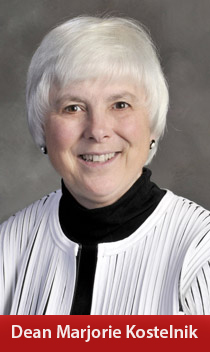
[Editor's Note: Marjorie Kostelnik, Dean of the College of Education and Human Sciences at the University of Nebraska-Lincoln testifed before the Nebraska Legislature's Education Committee in support of LB773, which will create a task force to study our state's early childhood education workforce and make recommendations to address the preparation and training of early childhood education professionals. This blog post is adapted from her written testimony.]
Broad consensus exists that teacher quality matters—teacher quality makes a difference in our K-12 system and it makes a difference in our colleges and universities. But nowhere does teacher quality have a greater impact than with our youngest children. As a former Head Start teacher, child care provider, early childhood center director and teacher, and now researcher and administrator in higher education, I know from first-hand experience that Nebraska’s infants, toddlers and preschoolers have every bit as much need for interacting with highly qualified professionals as do our students in K-12 schools and colleges and universities.
We know developing children need supportive, caring adults in their lives—parents, grandparents, and extended family all play a crucial role. With such a high number of Nebraska families in the workplace, it’s also important that these children spend their days in high-quality environments surrounded with qualified, competent workers.
Based on research, here’s what we know about young children and early childhood educators. Young children who have access to high-quality early childhood programs for a year or more exhibit:
- More favorable attitudes toward school and teachers
- More positive attitudes toward themselves as learners
- Fewer negative social behaviors
- Higher level thinking skills
- Better memory skills
- Stronger mathematical problem-solving skills
- Higher levels of scientific interest
- Better reading comprehension
- More developed listening skills
- Increased vocabulary and language skills
These results do not come about simply because children are in any organized program; the program must be high quality. In fact, poor-quality programs can actually detract from or even harm children’s development and learning.
One of the biggest indicators of a high-quality environment is the early childhood workforce. In high-quality settings, educators determine the quality by:
- Establishing close relationships with children and families
- Formulating effective routines
- Creating safe and stimulating physical environments
- Addressing whole child learning—physical, social, cognitive, language and aesthetic
- Knowing when to intervene and how to support children’s emerging knowledge and skills in all areas of development
- Encouraging child exploration and play
- Modeling behaviors and attitudes
- Communicating societal expectations and guiding children’s social behavior
All these conditions are in our grasp to achieve, but many children in Nebraska do not have access to well-trained early care and education professionals and high-quality early learning programs.
Here are two examples I’ve personally experienced in early childhood settings.
Missed Opportunities
Imagine you are visiting an early childhood program for 3- and 4-year-olds. The space is lovely—new furniture, lots of materials and pretty pictures on the wall. You think, “What a great place for kids.” Just then, a child bursts into the room whimpering. The adult following her says, “Rosalie, don’t be such a baby. Now hush. Go wash your hands for lunch.” As the other children file in, you hear a boy say, “Look what I found—he holds up a big fat wriggling worm. A different adult says, “Get rid of that thing. You’re getting dirt all over the place. Do you want to get sick?” A few minutes later two children are arguing over a chair at the lunch table, an adult separates them and sends each child to sit at a table far away from the other. Your initial favorable impression changes.
The adults in this setting are harried and overwhelmed. They don’t see themselves as teachers at all—they are just trying to keep things under control. As a result, they miss golden opportunities to support children’s learning, like the opportunity to comfort a child in distress and to help that child develop coping skills, the opportunity to encourage a child’s interest in science and the natural world and the opportunity to coach children through a conflict. Within the space of a few minutes there were many different lessons to be explored, but the adults failed to recognize the opportunities before them and their roles in guiding children toward greater competence.
The Shoppers
Four-year-old Emilio was standing near the pretend store in the play yard, unsure of how to get involved. He tried asking and saying please, but neither strategy worked. The other children didn’t know what to do with him and he had no idea what to try next. Emilio’s teacher saw this. She approached him and handed him a paper bag to ‘go shopping.’ She took him by the hand and together they entered the place where Marta and Carston were putting groceries made out of boxes, sticks and leaves on shelves they had made out of two picnic benches. His teacher said, “Hello, we’re shoppers. What is good to buy at this store?” Carston looked around, gathered some twigs and said, “This spaghetti is good.” The teacher asked Emilio, “What do you think, Emilio, should we buy spaghetti today?” Emilio nodded yes. She helped him put the spaghetti twigs in the bag. Then she said, “Ask Carston how much it costs.” The play continued with Carston, Marta and Emilio counting out the cost of things to buy using stones.
Emilio’s teacher used modeling and introduced scripts to help him become involved with the other children. Her actions and words gave Emilio a model to imitate and helped the other children figure out what to do with a new player. She also took advantage of the play to reinforce the notion of cost and counting. Everyone had exposure to new social, language and cognitive skills.
The contrast between these two scenarios demonstrates the difference children experience from being with less-trained practitioners versus those with appropriate training and education. Adult knowledge and skills are absolutely essential. This applies to a wide array of people who make up the early childhood workforce—teachers, child care providers, health professionals, program leaders and administrators.
LB773 is a Step Toward Consistent Quality
Ultimately, what we need to do as a state is support consistent quality and coherence of professional training across educational venues, roles, age groups and settings for ALL early childhood practitioners who work with young children and their families. LB773 is an important step toward establishing higher quality programs and a better educated early care and education workforce in Nebraska.
Dean Marjorie Kostelnik
College of Education and Human Sciences
University of Nebraska


